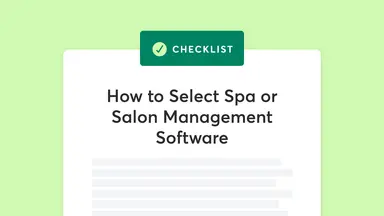
The Ins and Outs of Salon Memberships with Emerson Joseph
July 31, 2023
This hasn’t been an easy year, and when times are tough, it’s good to know your salon is going to have cash continuing to come in. Salons and barbershops that employ a membership model know just that. There are many benefits to offering a membership program to salon clients. Salons and barbershops with such a membership option have recurring revenue coming in. Memberships create stability for your business and foster ongoing relationships with clients.
Not quite sure how to get started with a membership program? I recently sat down with Zach Edwards, the owner of Emerson Joseph in Charlotte, NC. Emerson Joseph is a men’s grooming lounge that offers a high-end experience. Edwards credits much of the success of the business to its membership plan.
Chris Nedza: This whole idea of memberships really fascinates me, because I've often thought if you could figure out a way to do recurring revenue, not gift cards but actually recurring revenue, it would be an incredible lifesaver to a lot of salons and spas. Did you start with memberships? Or, when did you start, and how did you get going with it?
Zach Edwards: The old owner had a membership structure similar to ours. We have tweaked it throughout the years to make it more of a regular revenue stream. He had designed it in a way that allowed them to capture big chunks; it could help with cash flow immediately. They did a paid-in-full, almost like a gift card. So, they could capture $1,000 for a year's worth of services in a day and then apply that towards the payroll that week or something. We still have a paid-in-full option, because a lot of clients like that option. But I've really pushed on getting the monthly revenue, and we break it up so that the payments are collected on the first and the 15th, which goes along with our payroll dates. We use it to measure our cash flow and to help regulate cash flow. We always know that on the first and the 15th there's going to be a big chunk of money going in the account. And on the first and the 15th, there's going to be a big chunk of money going out, but that chunk of money for the payroll is going to be covered.
CN: Right. Now, you don't have 100% of your clients on memberships, correct?
ZE: A lot of my metrics are different this year. In a normal year, 25% of our clients are members. It's a nice cushion to know that you're always going to have a solid stream of revenue coming through your salon every month that—no matter what—you can count on.
CN: Why is it a good idea to offer a membership program? Now one thing you said is it smooths out your cash flow. But there's a couple of other reasons, right? How does that impact loyalty from the customer? And loyalty from the employee?
ZE: Memberships help you regulate your cash flow; they're really useful for that. They also keep clients loyal to the salon—or certainly at least the next $1,000 or whatever you price your membership at.
When you have strong customer loyalty like that, you end up with strong employee loyalty. In addition to a good culture, this is one of the things the extra things that really does help solidify retention. Stylists know customers are loyal to the business, and it makes them consider how many of their customers can they bring with them if they were to leave.
CN: Can you give me a couple of ideas how a membership program works and how to launch it?
ZE: Our structure is similar to a gift card—though legally and technically different—but it's similar to a gift card in the sense that you buy $1 value in services upfront. The way we run ours, there are four different levels or membership prices: silver, gold, platinum, and black. The most common is our gold level, which is $800 to purchase and you get $1,000 worth of services over the course of the year. That's the most popular, although a lot more people are now getting platinum levels (purchased for $1,000 and they get $1,300 worth of services).
Along with that, we try to do additional benefits. We partner with other five-star brands in town. We've partnered with Ruth's Chris, Capital Grille, and high-end custom suit makers. We give them gift cards and they give us gift cards, or they give our members a discount. For a while, Ruth's Chris was doing a free bottle of wine to any Emerson Joseph member—any time they came in. For Ruth's Chris, they look at it like, "Okay, well, here's a qualified customer coming through the door. If they get a bottle of wine, they're probably going to get food along with that." And for us, we got to advertise that one of the perks of being a member at Emerson Joseph is you always get a free bottle of wine at Ruth's Chris.
CN: Talk to me about the country-club feel of being a member.
ZE: I think that's probably clients' favorite benefit of the membership. It really does create sort of a country-club feel; we insist that all our staff know all the members by name and greet them by their name. Even if it's not technically your client, you still need to know who that guy is and what his name is and say hello.
And when clients check out, it's seamless because we have their points on file. A lot of them leave a tip account or leave their card on file. We know the standard tip that they want to leave, and they get to just walk out the door and wave goodbye. There's no checkout, there's no business transaction that takes place; they walk in, they're greeted, they walk out. They get to go about their day. They don't have to stand in line. There's no waiting, and they really like that.
CN: How do you convert a customer who's just a walk-in or an appointment-based customer over to a membership?
ZE: You know, it's funny. The easiest customers to convert are first-time customers. We have a much higher conversion rate on first-time customers than we do on long-standing customers.
You get all your staff talking about the membership program. We talk about it in every single day's huddle. They all have membership quotas. They get a commission on the membership sale, and they have a number they're supposed to reach. It changes based on how much volume somebody does. But we talk about it every day in huddles, and they push it. They get to give a tour of our salon, and they're proud of our salon. We have a speakeasy in the basement. They get to bring members down there. Members get to access the speakeasy in the basement. They get to show it off and talk about a membership, and a lot of guys are like, "Okay, sign me up."
CN: That's awesome. I love that. Do you think this membership model is for every salon?
ZE: Yes, I think a model like this could be used in every salon. No matter what people need to get their hair cut, and everybody has a place that they like to go. If they find somebody they like, they stick with them. And so, memberships are just really retaining that customer as a customer of the brand rather than a customer of that stylist.
CN: What would you say to salon owners who don't have memberships?
ZE: I'm a numbers guy. The thing that resonated the most to me was the struggle to manage cash flow. Memberships can give you that stability. Everybody in this industry knows what it's like to have good months and bad months, to have ups and downs, good years and bad years. They experience the fear of an employee leaving or several employees leaving. And what are they going to do if all those customers leave, too? What are you going to do if all your staff walks out? To know that you have retained those clients with memberships, despite what happens internally, that level of stability in this industry is hard to argue with. We all want to do things to create stability within our salons. Creating stability within the client base is the central thing. That's what we're all here for—the clients.
CN: I've found that the biggest fear salon owners have, and the biggest reason they push back on any kind of change, is fear of a walkout. I see it so often. Do you think it's a big deal to make this change? How would you do it?
ZE: I have had a walkout. It was within the first six months that I purchased the business. It was planned before I purchased the business, but I didn't know about it. I came in one day and there was only one staff member left. I know what that feels like. I lived with being afraid of that for the next few years, because I always was worried it could happen again.
I would bet anything that I will not have another walkout. I would just be shocked if we had another walkout at this point. I believe in the stability of my business. I would say that a large part of that is due to the fact that we have such a strong membership base and so much customer stability within the business.
We still have employee turnover. Just last year I had somebody who worked here for seven years leave, and that was hard.
We have employment contracts, but let's be honest, what you really have to do to create stability within your employee base is create stability within your salon. And memberships create stability within the business.
CN: You do have to have a good culture. People do come and go, but a walkout can be devastating. I see people experiencing that with the COVID crisis right now.
ZE: We haven't lost a single employee in this COVID crisis. We've retained 100% of our employees. When we were closed, we furloughed, but we still have our employee base. And that's a big difference compared to a lot of other salons in our area. I know good friends who own salons in town that have closed after 10 years of being in business, because they had a walkout because of COVID-19.
I don't think we're special. I just think we've put better policies in place.
CN: Well, I do think you're special. You're putting in processes. I love the fact that you've focused on these memberships. I want to shout it to the top of the mountain tops: memberships are a game changer. Thank you for your time, Zach. We're pulling for you at Mindbody.



